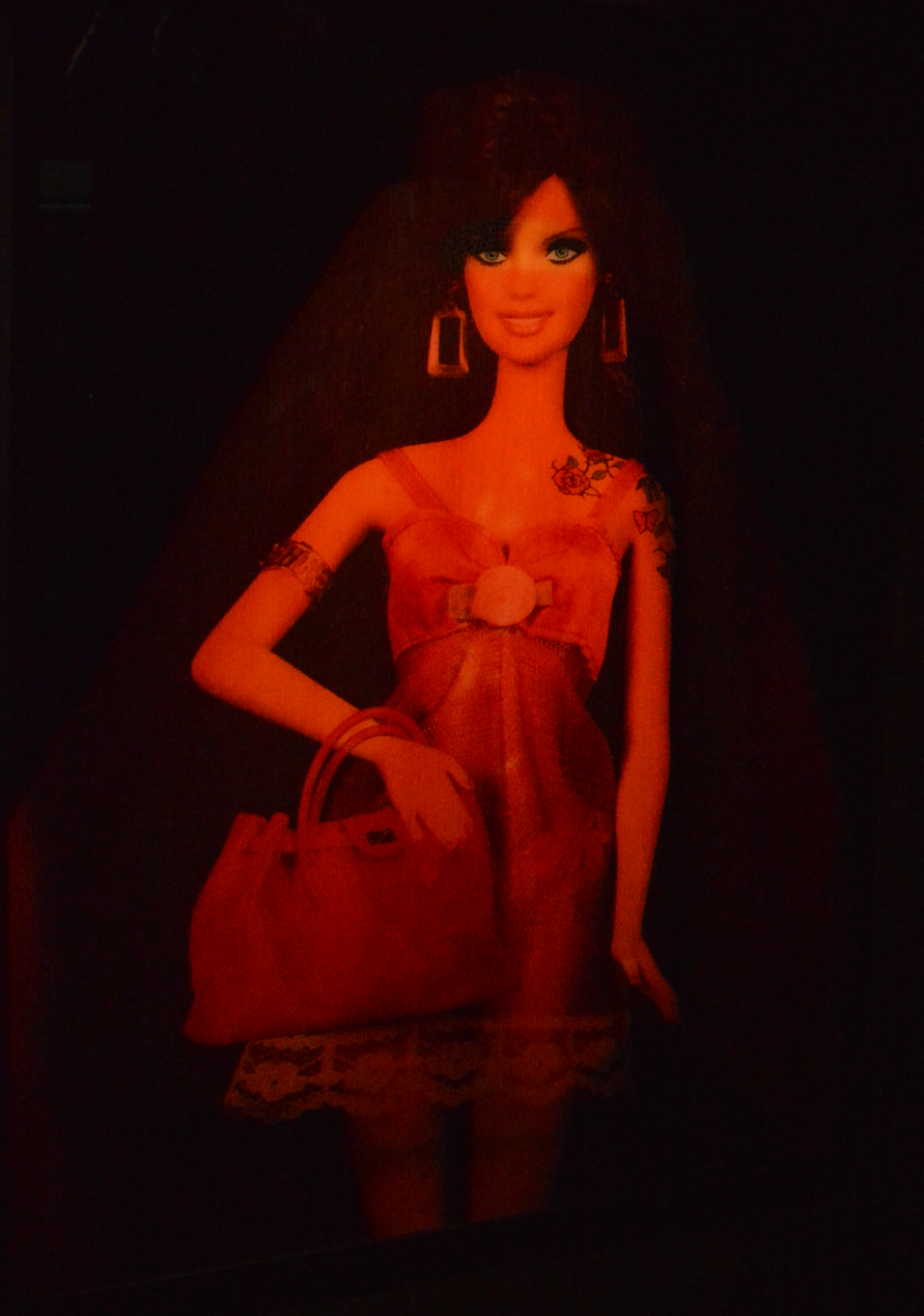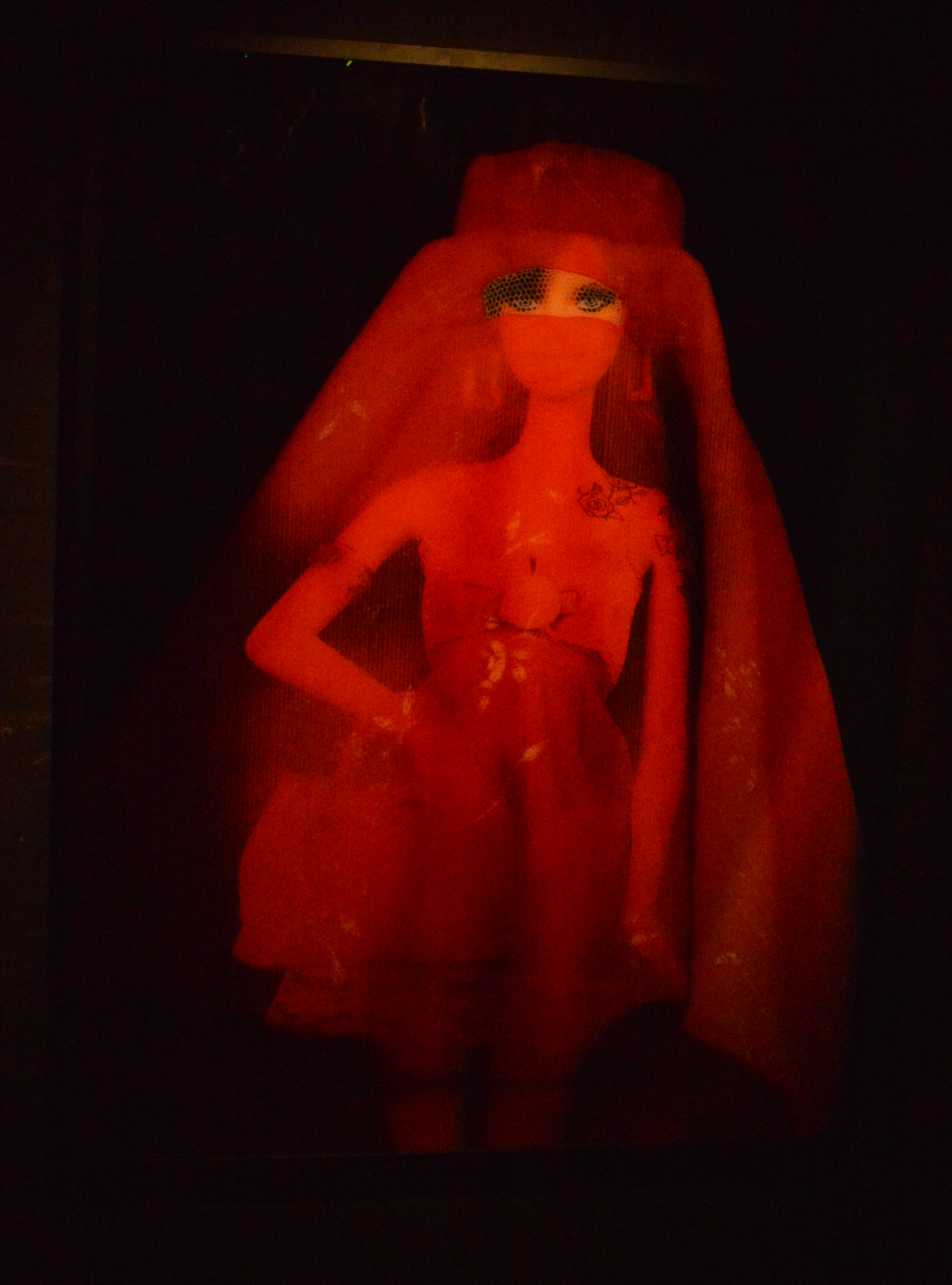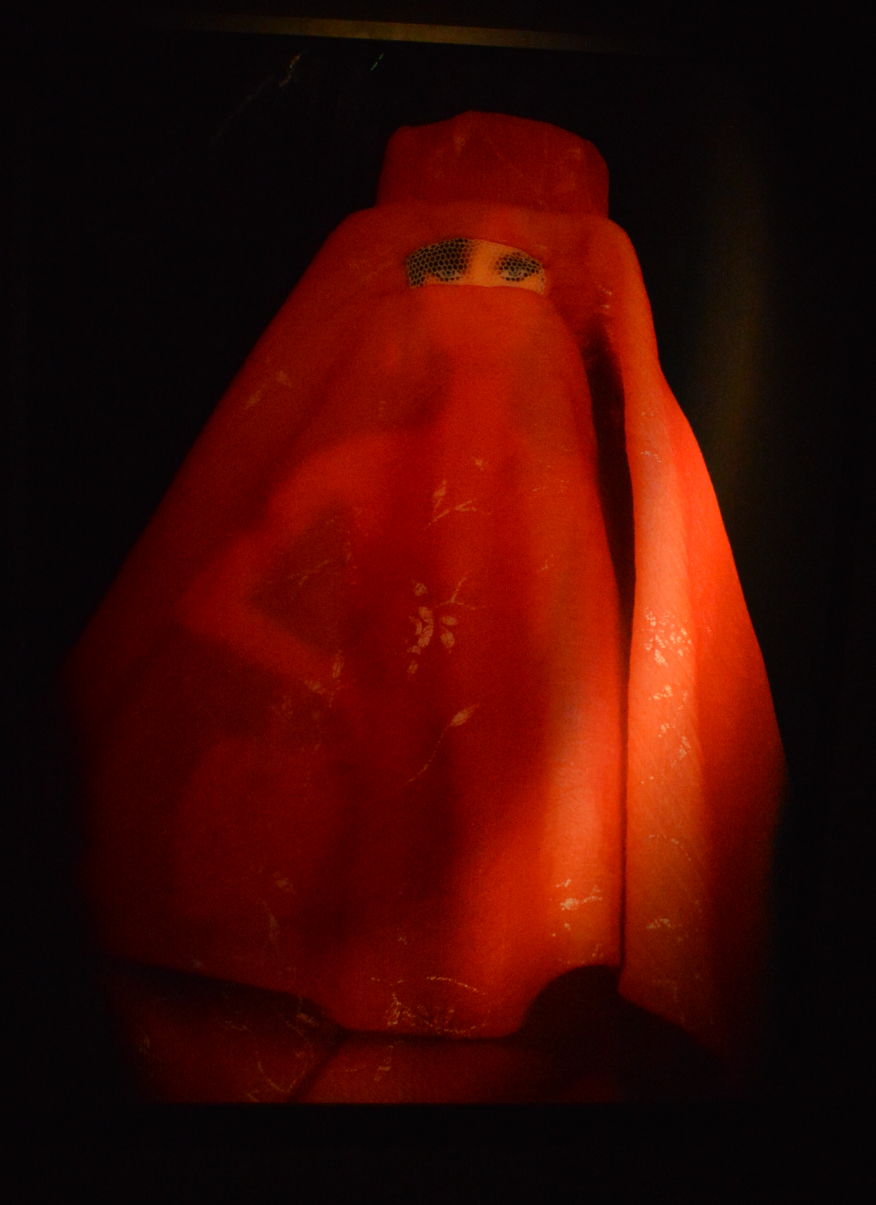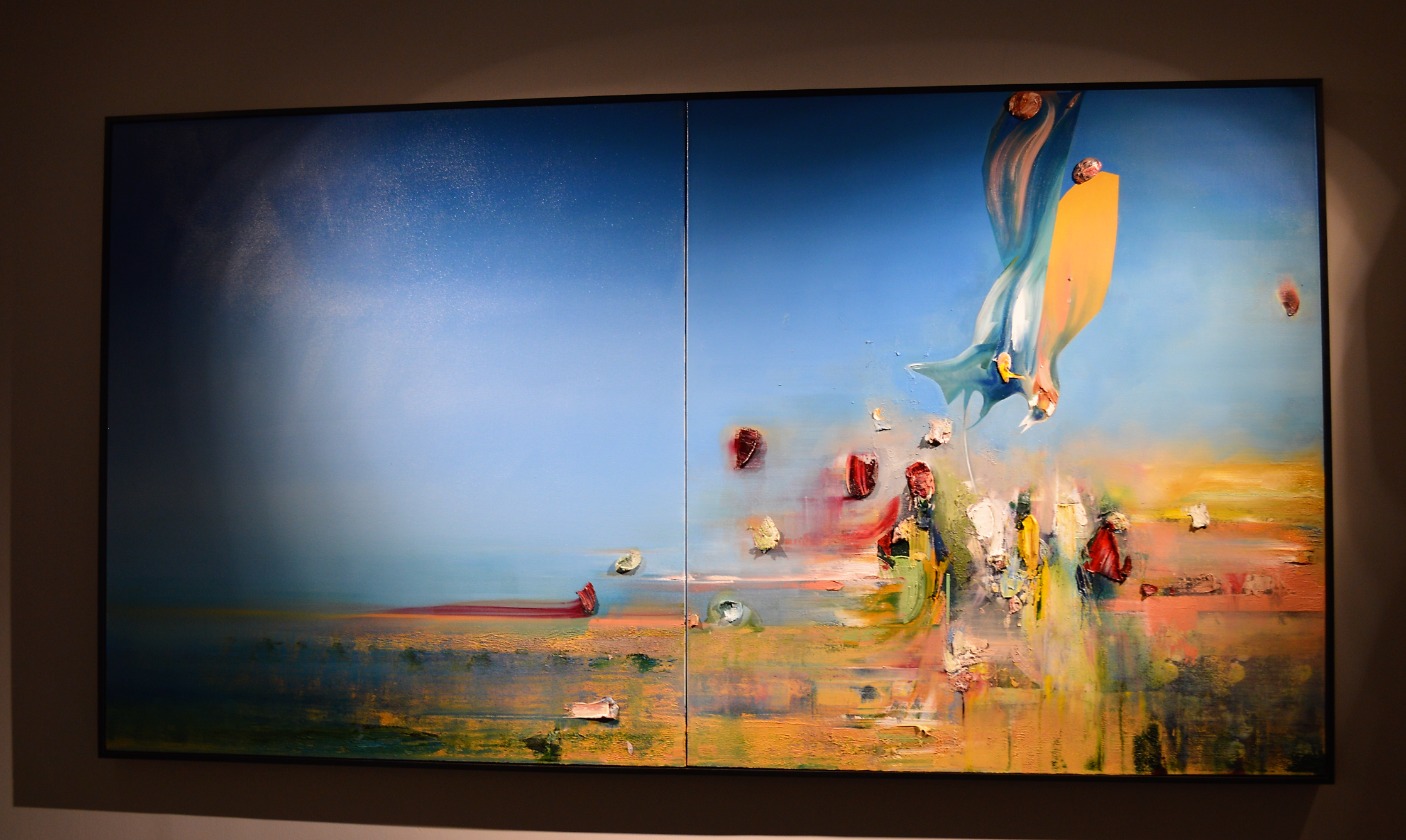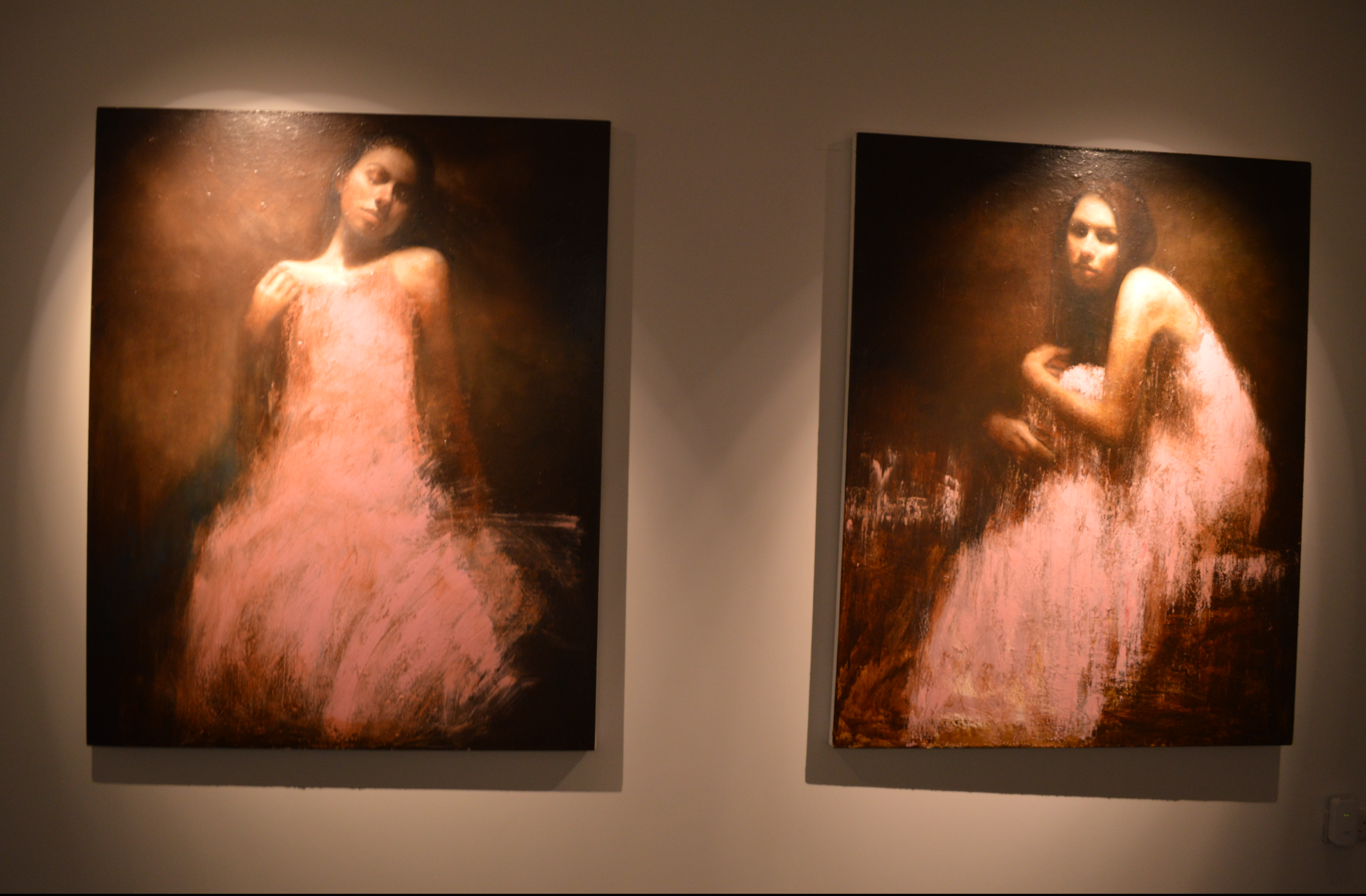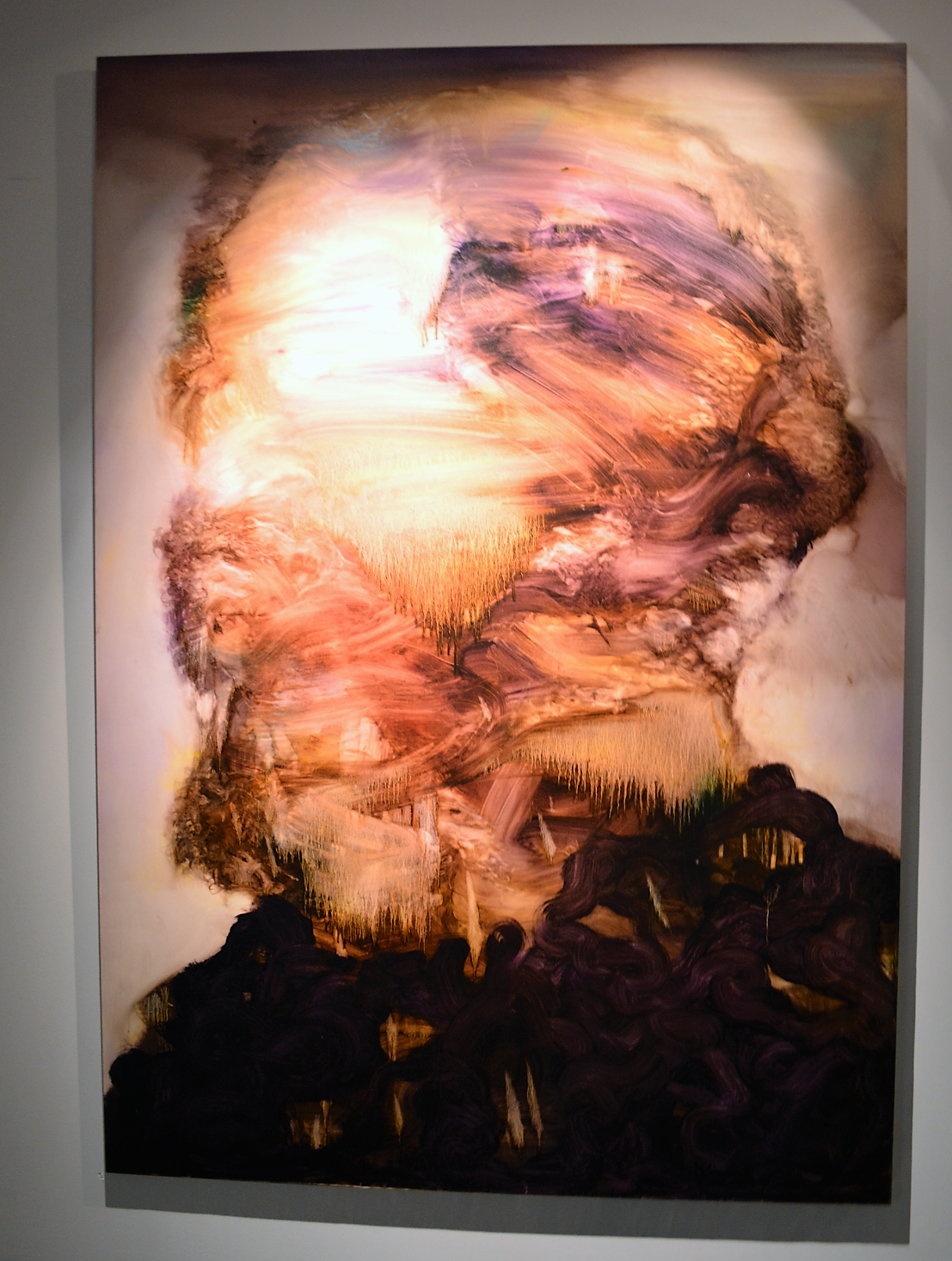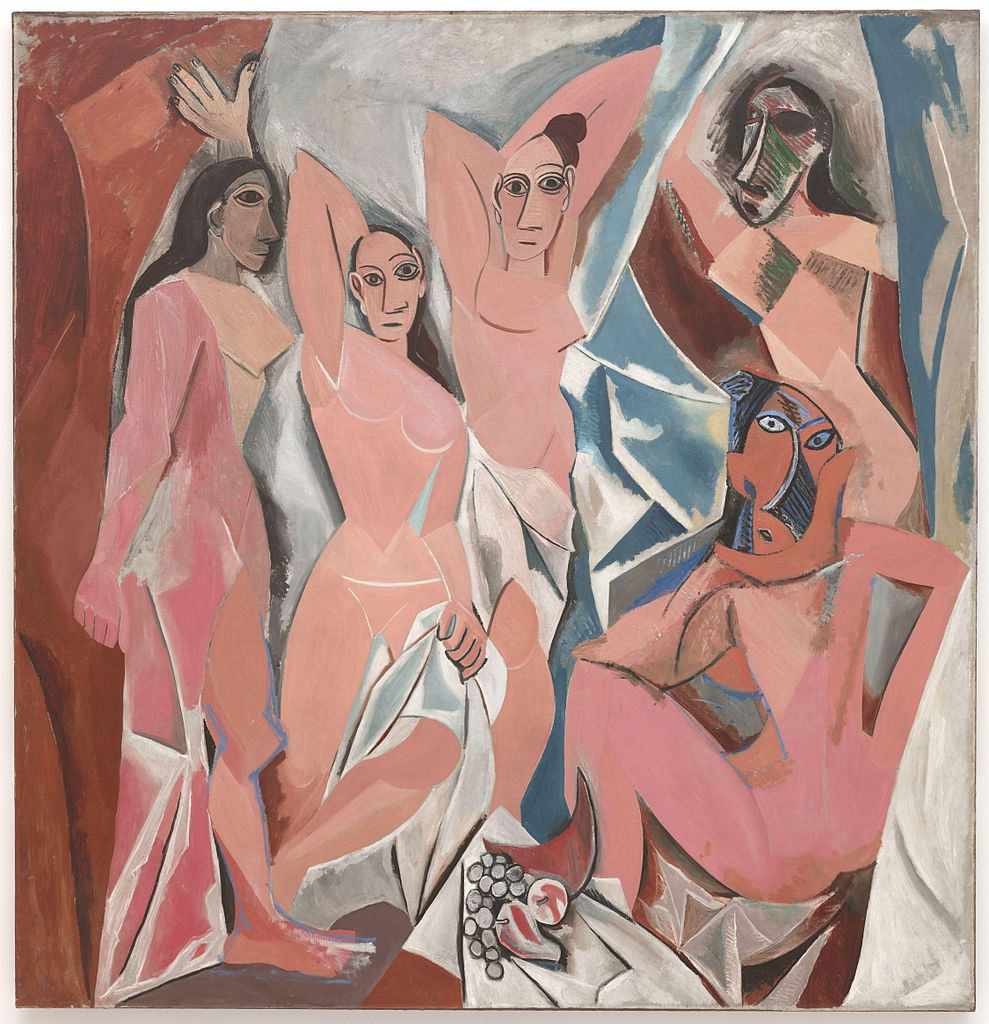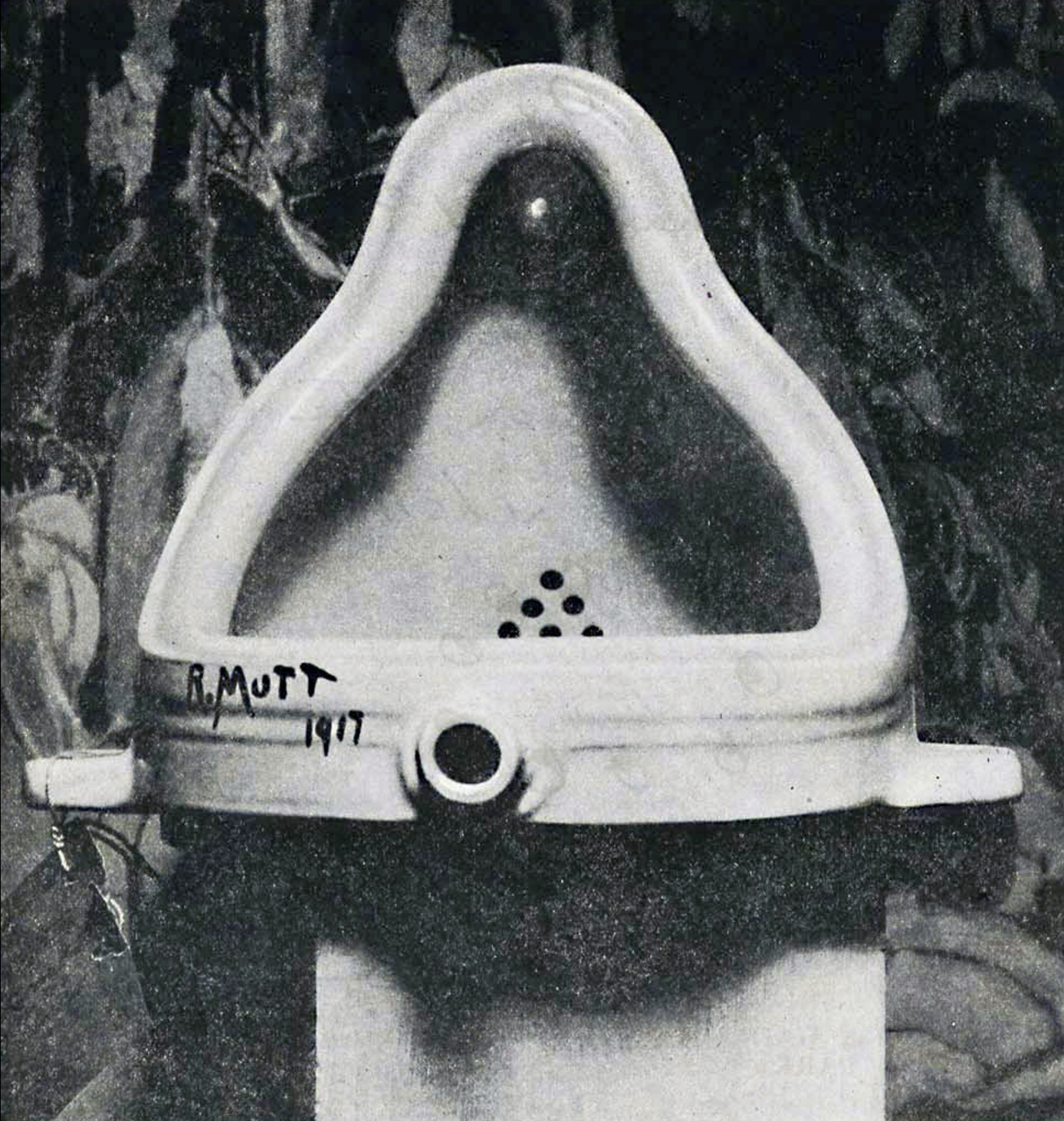Difference between revisions of "AGArde"
From Londonhua WIKI
| (2 intermediate revisions by the same user not shown) | |||
| Line 65: | Line 65: | ||
==Unit London== | ==Unit London== | ||
| − | + | {{Infobox | |
| − | + | |title = | |
| − | + | |header1 = | |
| + | |bodystyle = width:25em | ||
| + | |image = [[File:UL1.PNG|x450px|alt=Sofia Reyes]] | ||
| + | |caption = | ||
| + | |label2 = Location | ||
| + | |data2 = 147-149 WARDOUR STREET | ||
| + | SOHO, LONDON W1F 8WD | ||
| + | 11AM - 7PM, EVERY DAY | ||
| + | }} | ||
| + | "Located in Soho, classified by tourists as one of the most Avant-Garde neighborhood, it is a spot for shadiness and cheap food and music, stand-up comedy and cabaret performances. This is a great area to experience different forms of culture, from cuisine to clubs."<ref> Neighborhood Guide to London. (2016, December 23). Retrieved June 17, 2017, from https://www.bohemiantrails.com/5-neighborhoods-of-london-avant-garde-traveler/ </ref> Unit London is located right it the middle of all this. This gallery looks simple from the outside but has some of the best modern art in London. You can see culture, Emotions, techniques in each work of art, "Founded in 2013 by two young artists, Unit London was born from a desire to break down the barriers of elitism and to include people in the contemporary art world - whether they be enthusiasts, first-timers, new collectors, or seasoned collectors and institutions - we strongly believe that everybody should be able to enjoy the world's most amazing art. "<ref> About Us. (n.d.). Retrieved June 17, 2017, from http://theunitldn.com/about-us/ </ref> | ||
| + | <br> <br> | ||
| + | This Gallery is very inclusive and is open 7 days a week until the early evening. They provide a space for artists and visitors an open space to express themselves. | ||
| + | ''We have always wanted to provide a platform for the world's most exciting talent to showcase their work to the widest possible audience. We don't believe that incredible work should be reserved for only the select few. We are strong believers in the power of online, and we use digital and social media to broadcast our artists and their work to audiences all over the globe.'' <ref> About Us. (n.d.). Retrieved June 17, 2017, from http://theunitldn.com/about-us/ </ref> | ||
| + | <br><br> | ||
| + | |||
| + | |||
| + | |||
| + | {{Infobox | ||
| + | |title = PRISMATIC BRUISER | ||
| + | |header1 = | ||
| + | |bodystyle = width:25em | ||
| + | |image = [[File:UL3.PNG|x450px|alt=Sofia Reyes]] | ||
| + | |caption = 2017 | ||
| + | |label2 = MAterial | ||
| + | |data2 = Fibreglass life-cast with prismatic finish. | ||
| + | 120 x 52 cm | ||
| + | }} | ||
| + | |||
| + | Most Artists in this gallery started as street artists with u a unique aesthetic and technic has made them famous. A great example of this is the artists is Schoony. His brilliance has brought the art world by storm and his hyperrealist sculptures question war, mortality and contemporary society. PRISMATIC BRUISER is one of his most famous sculptures. It reminds me of Degas's. "Schoony’s background is rooted in special effects and prosthetics for the film industry, with his career spanning over twenty-five years. Since the age of fifteen he has worked on over a hundred films, his work and reputation for high-class pioneering techniques has reached the far corners of the world." | ||
| + | <br><br> | ||
| + | Altogether with his unique technique Schoony has had many different themes, examining capitalism and pop culture. He has a keen eye that provides the capacity to create such magnificent sculptures. As the gallery says it their webpage: "Schoony’s career has gone from strength to strength, exhibiting widely throughout Europe and the US. His work has won him critical acclaim from the Times, The Independent and ArtNet News, he is also featured on Artsy." <ref> About Us. (n.d.). Retrieved June 17, 2017, from http://theunitldn.com/about-us/ </ref> | ||
| + | {{Infobox | ||
| + | |title =PARALLAX | ||
| + | |header1 = | ||
| + | |bodystyle = width:25em | ||
| + | |image = [[File:UL4.PNG|x450px|alt=Sofia Reyes]] | ||
| + | |caption = 2017 | ||
| + | |label2 = Material | ||
| + | |data2 = Oil on canvas. | ||
| + | 120 x 52 cm | ||
| + | }} | ||
| + | |||
| + | Another British artist that has had an exhibition at this gallery is Tom French, a highly collectible and well-regarded artist. He creates monochromatic canvases. This black and white canc=vases are unique and have very precise detail. In these canvases you can find faces, figures and skulls repeat and shadow one-another. This simplicity of colors allows him to transmit his message easily with no distraction. "Each scene is a snapshot of a story, with a dynamic between the characters working on various levels, which ties into the bigger picture; there's much more to these images than illusion alone." Tom French | ||
| + | |||
| + | |||
| + | <br><br> | ||
| + | ''Other Works exhibited in this Gallery'' | ||
| + | <gallery> | ||
| + | Image:UL5.PNG| | ||
| + | Image:UL6.PNG| | ||
| + | Image:UL7.PNG| | ||
| + | </gallery> | ||
| + | |||
| + | <gallery> | ||
| + | Image:UL8.PNG| | ||
| + | Image:UL9.PNG| | ||
| + | Image:UL10.PNG| | ||
| + | </gallery> | ||
| + | <br><br> | ||
| + | |||
==Serpentine Gallery== | ==Serpentine Gallery== | ||
*has a purpose | *has a purpose | ||
| Line 180: | Line 239: | ||
Kandinsky believed that abstract paintings could convey spiritual and emotional values simply through the arrangement of colours and lines. Cossacks was made during a transitional period, when he retained some representational elements, such as the two Russian cavalrymen in tall orange hats in the foreground of the painting. Kandinsky considered these as points at which the images could be registered, rather than the true content of the painting. <ref> Tate. "'Cossacks', Wassily Kandinsky, 1910-1." Tate. N.p., n.d. Web. 21 June 2017. <http://www.tate.org.uk/art/artworks/kandinsky-cossacks-n04948>.</ref> | Kandinsky believed that abstract paintings could convey spiritual and emotional values simply through the arrangement of colours and lines. Cossacks was made during a transitional period, when he retained some representational elements, such as the two Russian cavalrymen in tall orange hats in the foreground of the painting. Kandinsky considered these as points at which the images could be registered, rather than the true content of the painting. <ref> Tate. "'Cossacks', Wassily Kandinsky, 1910-1." Tate. N.p., n.d. Web. 21 June 2017. <http://www.tate.org.uk/art/artworks/kandinsky-cossacks-n04948>.</ref> | ||
<br><br> | <br><br> | ||
| + | <br><br> | ||
| + | {{Infobox | ||
| + | |title = Cossacks | ||
| + | |header1 = | ||
| + | |bodystyle = width:25em | ||
| + | |image = [[File:Kandisky1.jpg|x450px|alt=Sofia Reyes]] | ||
| + | |caption = 1910–1 | ||
| + | |label2 = Display Room | ||
| + | |data2 =Level 2: Start Display | ||
| + | }} | ||
| + | <br><br> | ||
| + | |||
| + | =<font color=" #FF1493 ">A London Full of Colour</font>= | ||
| + | {{Infobox | ||
| + | |title = Kristy Giacoman | ||
| + | |header1 = | ||
| + | |bodystyle = width:25em | ||
| + | |image = [[File:Kristy.PNG|x450px|alt=Kristy Giacoman]] | ||
| + | |caption = | ||
| + | |label2 = Location | ||
| + | |data2 = Hyde Park | ||
| + | }} | ||
| + | |||
| + | =Overview= | ||
| + | <font color=" #FF1493 ">"A London Full of Colour"</font> is a project that aims to portray a different reality of the daily life of London citizens. By picturing different scenarios in their reality comparing them to the reality that I choose for each one of them, the audience is able to admire the beauty and uniqueness of the city from a different perspective. I have gone to international poetry competitions and taken painting and photography courses before arriving to college. This project combines my favorite forms of expression through art and hopefully brightens the days of the viewers. The main message I wished to convey is that every single one of us chooses the reality they want to live in, meaning that the same place could be seen as a prison for our souls or a wonderland for our imagination. | ||
| + | |||
| + | <br><br> | ||
| + | |||
| + | =Milestone 1= | ||
| + | <br> | ||
| + | <font color=" #FF1493 ">'''Colourless London'''</font><br> | ||
| + | '''Objective:''' The goal is to display London as it is and to capture through pictures emotions felt by the Londoners due to the weather. Pictures are taken from different perspectives and represent feelings of an average citizen. | ||
| + | <br><br> | ||
| + | In the course of two weeks, I researched the weather conditions in the United Kingdom, the origin of the deadly London fog and the relationship between people's emotions and weather conditions. This lead to the visual representation of my findings through a set of pictures taken on the city capturing the feelings talked about in the background. London looks like a majestic city and it's weather just adds to the mystery and enchantment of its beauty. However, people have had a different perspective than mine since centuries ago. | ||
| + | <br> | ||
| + | [[Colourless London|Read More]] | ||
| + | <br><br> | ||
| + | |||
| + | =Milestone 2= | ||
| + | <br> | ||
| + | <font color=" #FF1493 ">'''Adding Pigment'''</font><br> | ||
| + | '''Objective:''' The goal is to paint five acrylic surrealistic paintings of the most emblematic sites in London exaggerating the use of bright colors instead of the usual gray palette that is seen due to the weather. | ||
| + | <br><br> | ||
| + | The background exposes six different artists from three different fields; painting, literature, and architecture. From the magnificent paintings of Monet to the Breathtaking structures of Sir Christopher Wren and the stories of Charles Dickens together with Hockney's photographs, London is the birthplace of some of the most breathtaking artistic masterpieces. Unique, mesmerizing and complex, yet with a somehow volatile approach, artists throughout the history of this city have each shared their view through their work. Each one is analyzed in regard to the link between their style and perspective, and their setting and life circumstances. The artists are divided in "Artists from the past" and "Artists from the present" and while the first category shows monochromatic and deep emotions about the scenery in London, the second one proposes a new and brighter perspective to the same issue this city has dealt with for years. | ||
| + | <br> | ||
| + | [[Adding Pigment|Read More]] | ||
| + | <br><br> | ||
| + | |||
| + | =Milestone 3= | ||
| + | <br> | ||
| + | <font color=" #FF1493 ">'''Colourful Reality'''</font><br> | ||
| + | '''Objective:''' The goal is to connect the emotions displayed in the pictures and the colors of the paintings in a creative way empathizing with the people walking by the site as a daily routine. The paintings and pictures are accompanied by a poem. | ||
| + | <br><br> | ||
| + | Just as Mathew Arnold said; "Poetry is simply the most beautiful, impressive and widely effective mode of saying things". In this Milestone I explore the same reality from very different perspectives analyzing the lives of four of the most influential British Poets and one poem for each one of them. They all saw Britain grow and they grew with it as well, leaving a written proof of how each person is a master of their own destiny and how life is not about having, getting, and settling but about being, becoming and overcoming. These four authors that lived in very different times and lived in many places all through their lives show their personal view and chosen style through their work. We see through the writing of Mathew Arnold, Harry Baker, Richard Aldington and Don Patterson, different viewpoints about the weather and the sociopolitical situations that revolve around this the United Kingdom. What seems most interesting is the everlasting emotions displayed; everlasting in a way in which they are adopted again and again by newer generations as if the make choices and mistakes were made repeatedly throughout the ages. In this milestone it is possible to visualize the different perspectives of each author comparing them to each other and drawing your own conclusions. | ||
| + | <br> | ||
| + | [[Colourful Reality|Read More]] | ||
<br><br> | <br><br> | ||
Latest revision as of 21:32, 22 June 2017
Contents
[hide]Avant Garde
In French, the word avant-garde means "advanced guard" and they are the soldiers that go in front, they explore the territory before a fight and analyze the enemy. They are advanced and have knowledge like no one else has. Likewise, in art, avant-garde is a group of artists that are advanced by using new techniques and not following tradition.
- non-traditional
- new Techniques
- Modern Art
The protagonists of this tendency were united by the urge to break free from tradition and win social acceptance for a new art. Most of them produced their works of art during the first third of the twentieth century until fascism and Stalinism crushed their movements in Europe. [1] [2] Because of its radical nature and the fact that it challenges existing ideas, processes, and forms; avant-garde artists and artworks often go hand-in-hand with controversy.
The notion of the avant-garde Is based on the idea that art should be judged based on primarily on the quality and originality of the artist’s vision and ideas. This can be innovations on form, such as in cubism, which rejected traditional techniques of perspective, modeling, and foreshortening, and instead emphasized the two-dimensionality of the canvas and used multiple or contrasting vantage points. Other avant-garde artists had strong social programs, such as futurism or surrealism.
History
As mentioned above avant-garde is the movement in the 19th-century and 20th-century that was recognized by artists who didn't follow tradition. may of the world's most prominent artists are considered avant-garde but who began using this term?
the Begining
The term avant-garde was first used in art by Henri de Saint-Simon a socialist. As the art historian Donald Egbert said: "It has never previously been pointed out, I believe, that the figurative use of the word avant-garde to denote radically progressive leaders of both art and society" [3] Saint-Simon was a French Utopian socialist and predecessor of Karl Marx. [4] In Egbert's paper, The Idea of Avant-Garde in Art and Politics, he explains how Saint-Simon believed that artists were best fitted to change the society and how in his Opinions litteraires, philosophiques et industrielle he said:
- It is we, artists who will serve you as an avant-garde, the power of the arts is, in fact, most immediate and most rapid: when we wish to
- spread new ideas among men, we inscribe them on marble or canvas. What a magnificent destiny for the arts
- is that of exercising a positive power over society, a true priestly function and of
- marching in the van [i.e. vanguard] of all the intellectual faculties! [5]
- is that of exercising a positive power over society, a true priestly function and of
- spread new ideas among men, we inscribe them on marble or canvas. What a magnificent destiny for the arts
- It is we, artists who will serve you as an avant-garde, the power of the arts is, in fact, most immediate and most rapid: when we wish to
In this simple quote, he talks about many important things. He talks about the power art, in general, has and how avant-garde has very important. Art has been a method of communication of ideas, ideas that artists what to spread and that is why it has power. Avant-garde is a type of art that spreads new ideas that are going to change society and being in this movement is a smart choice. The key word in this quote is new, as it is what defines artists in this movement and even though many artists don't follow or believe in Saint-Simon's beliefs of socialism they still consider themselves part of this movement he first began.
Avant-garde started with realism, specially Gustave Courbet. He was strongly influenced by the ideas of socialism, Following the ideas of socialism Th avant-garde movement began with Expressionism specially with Avant-garde can be said
With realism, French painter Courbet is known to be the first Avant-garde artists just as he is considered the start of Modern Art. We can conclude that Modern Art and avant-garde go hand in hand.
Up to the present
- In the past a few, now soo many
- Maybe no new arists is going to be a Monet but they still have the same goals
- The art develops around the world's problems
- New techniques / New Culture
Protagonists
- Impressionism
- Claude Monet
- Renoir
- Pissaro
- Manet
- Post-Modernism
- Cezanme
- Degas
- Seurat
- Van Gogh
- Cubism
- Pablo Picasso
- Duchamp
- Gaugin
- Abstract Art
- Kandinsky
Deliverable
National Gallery
The well known National Gallery in London one of the most visited art galleries in the world. People from all over the world come to this gallery to admire works of art located here. It contains artists from all over the world and many time periods. This gallery is divided into time periods, in the map above each specific time period is a different color. My personal favorite is the are from 1700-1930 (green on the map) because it contains almost all the artists I mentioned above. All thought the green zone you can find avant-garde artists. For the purpose of this project, I chose three rooms that had the most avant-garde art. In rooms 41,43 and 44, you can see art from Monet's time in London to Van Gogh's famous sunflowers.
Tate Modern
I consider this Gallery the best place to observe modern and contemporary art. The unique architecture of the building misguide you at first, however, from the lowest level call the "The Tank" to the viewing level where you can see all the city, you can observe incredible works of art. As Modern Art and Avant-garde go together, this place is also great for avant-garde art. Many of the artists mentioned above can be found here and much more new artists that fall into this category. Below I provide information about three pieces that are irrefutably avant-garde. This pieces will mark this movement forever and being able to admire them in this gallery was amazing.
Bankside London SE1 9TG
Unit London
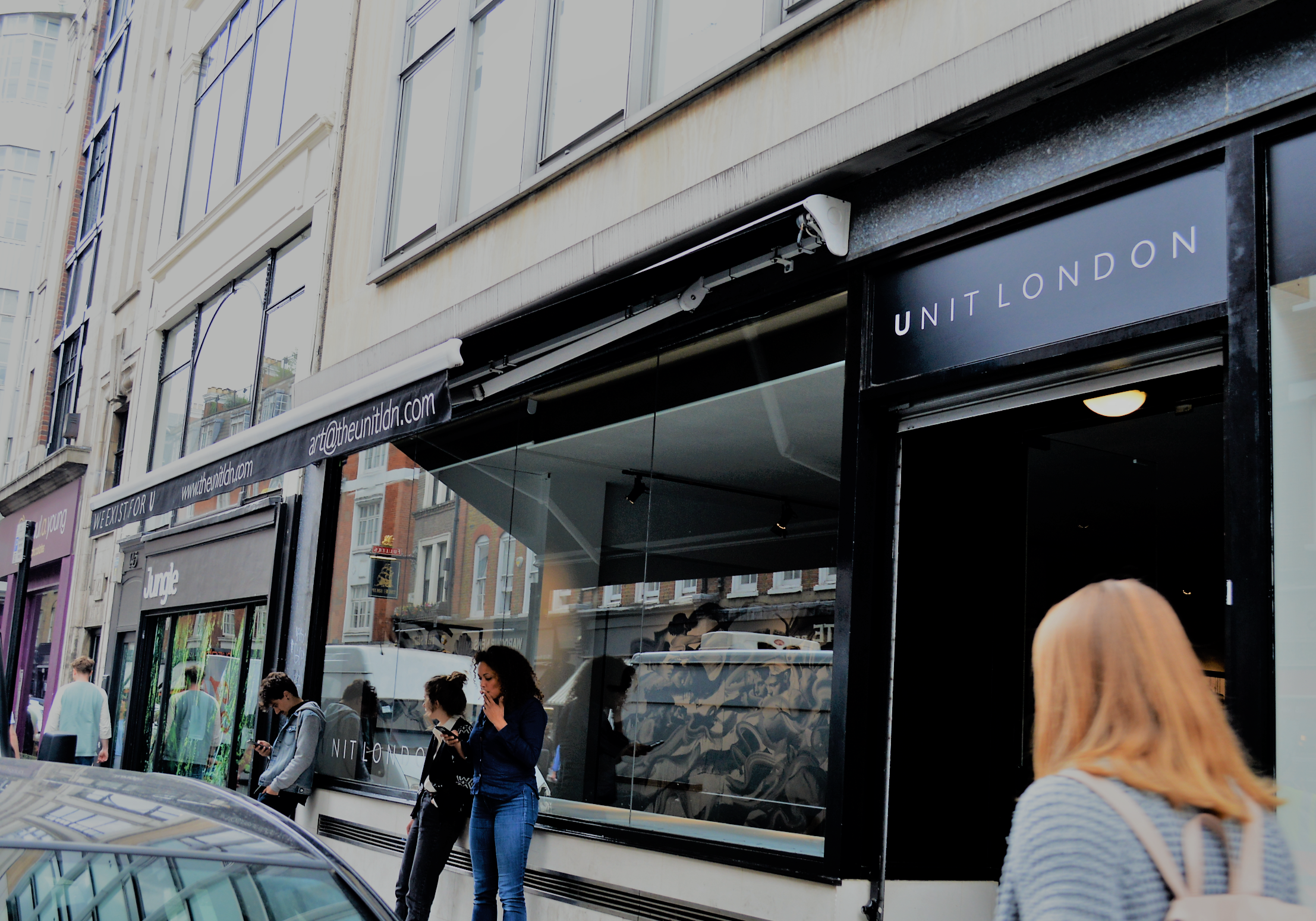 | |
| Location |
147-149 WARDOUR STREET SOHO, LONDON W1F 8WD 11AM - 7PM, EVERY DAY |
|---|---|
"Located in Soho, classified by tourists as one of the most Avant-Garde neighborhood, it is a spot for shadiness and cheap food and music, stand-up comedy and cabaret performances. This is a great area to experience different forms of culture, from cuisine to clubs."[7] Unit London is located right it the middle of all this. This gallery looks simple from the outside but has some of the best modern art in London. You can see culture, Emotions, techniques in each work of art, "Founded in 2013 by two young artists, Unit London was born from a desire to break down the barriers of elitism and to include people in the contemporary art world - whether they be enthusiasts, first-timers, new collectors, or seasoned collectors and institutions - we strongly believe that everybody should be able to enjoy the world's most amazing art. "[8]
This Gallery is very inclusive and is open 7 days a week until the early evening. They provide a space for artists and visitors an open space to express themselves.
We have always wanted to provide a platform for the world's most exciting talent to showcase their work to the widest possible audience. We don't believe that incredible work should be reserved for only the select few. We are strong believers in the power of online, and we use digital and social media to broadcast our artists and their work to audiences all over the globe. [9]
 2017 | |
| MAterial |
Fibreglass life-cast with prismatic finish. 120 x 52 cm |
|---|---|
Most Artists in this gallery started as street artists with u a unique aesthetic and technic has made them famous. A great example of this is the artists is Schoony. His brilliance has brought the art world by storm and his hyperrealist sculptures question war, mortality and contemporary society. PRISMATIC BRUISER is one of his most famous sculptures. It reminds me of Degas's. "Schoony’s background is rooted in special effects and prosthetics for the film industry, with his career spanning over twenty-five years. Since the age of fifteen he has worked on over a hundred films, his work and reputation for high-class pioneering techniques has reached the far corners of the world."
Altogether with his unique technique Schoony has had many different themes, examining capitalism and pop culture. He has a keen eye that provides the capacity to create such magnificent sculptures. As the gallery says it their webpage: "Schoony’s career has gone from strength to strength, exhibiting widely throughout Europe and the US. His work has won him critical acclaim from the Times, The Independent and ArtNet News, he is also featured on Artsy." [10]
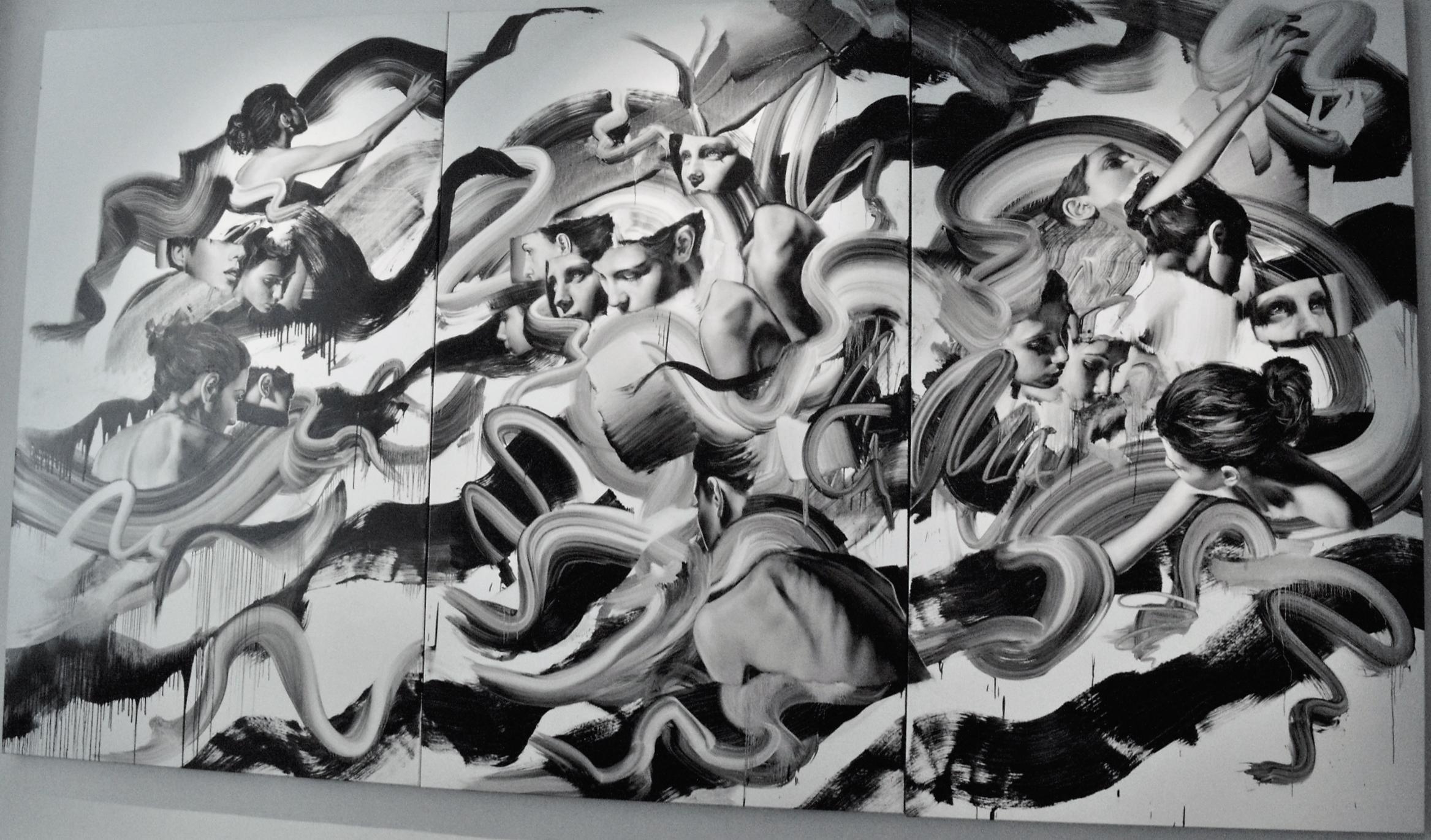 2017 | |
| Material |
Oil on canvas. 120 x 52 cm |
|---|---|
Another British artist that has had an exhibition at this gallery is Tom French, a highly collectible and well-regarded artist. He creates monochromatic canvases. This black and white canc=vases are unique and have very precise detail. In these canvases you can find faces, figures and skulls repeat and shadow one-another. This simplicity of colors allows him to transmit his message easily with no distraction. "Each scene is a snapshot of a story, with a dynamic between the characters working on various levels, which ties into the bigger picture; there's much more to these images than illusion alone." Tom French
Other Works exhibited in this Gallery
Serpentine Gallery
- has a purpose
- the Pavillion has a purpose
- both galleries have a purpose
- War and discrimination
- Awareness
Trash
The Beginning
The term first appeared in reference to art during the first half of the nineteenth century in France. TH influential thinker Henri de Saint-Simon, one of the forerunners of socialism. He had this idea that artists, alongside scientists and industrialists, were leaders of a new society. In 1825 he wrote:
- We artists will serve you as an avant-garde, the power of the arts is most immediate: when we want to
- spread new ideas we inscribe them on marble or canvas. What a magnificent destiny for the arts
- is that of exercising a positive power over society, a true priestly function and of
- marching in the van [i.e. vanguard] of all the intellectual faculties! [11]
- is that of exercising a positive power over society, a true priestly function and of
- spread new ideas we inscribe them on marble or canvas. What a magnificent destiny for the arts
- We artists will serve you as an avant-garde, the power of the arts is most immediate: when we want to
Avant-garde art can be said to begin in the 1850s with the realism of Gustave Courbet, who was strongly influenced by early socialist ideas. This was followed by the successive movements of modern art, and the term avant-garde is more or less synonymous with modern. The term avant-garde pretty much goes hand-in-hand with modern art. The Period 1851 to 1929 witnessed the rise of the major European avant-garde/modern groups: the Realists, Impressionists, Post-Impressionists, Symbolists, Cubists, and Surrealists. In the time period, it was also a time of rapid social, economic, and political change, encompassing a revolution in communication systems and technology, and an unprecedented growth in the availability of printed images. [12]
Some avant-garde movements such as Cubism, for example, have focused mainly on innovations of form, others such as Futurism, De Stijl or surrealism have had strong social programs.
Impressionism started in the early 1870’s as an interval of time between Realism and Symbolism. Artists were detached from objectivity and based their ideals upon sensation. Ideas such as expression of sensations derived from nature without any preconceived knowledge of nature. Many artists used short brush strokes and unblended vivid colors focusing on the effects of light. This style gave many works of art in this period a sense of spontaneity and modernity. [13]
Impressionism was founded by revolutionary artists such as starting with Claude Monet, Camille Pissarro, and Pierre Renoir, among others. Accused by critics as sketches or impressions and not finished art this artist painted the appearance of reality. Impressionist was too fond of free imagination and rejected objectivity and intellectualism.
Claude Monet
It can be said that Monet is the father of Impressionism with his new technique of immediate perception. We can admire this technique in a painting in the Worcester Art Museum called Water Lilies (1908). You can easily recognize Monet’s “Water Lilies” as he painted approximately 250 of them. Each painting is unique, but we can see how can his idea ever-changing image, the indefinite and freely painted forms also point the way toward the more expressive painting techniques. He painted at different times of the day the same landscape. In the Worcester canvas, we observe how he captures the light and pastel colors possibly indicating that it is early morning. He created this close up of the pond as he was observing with the cluster of lilies in the left bottom corner of the painting. Is easy to recognize them as lilies with his use brushstrokes of warm pinks and pastel green. In the rest, we can find an impression of a reflection of a tree with scattered lilies on it. By capturing the moment as quick as possible the pond seems realistic but with not as clearly defined contour lines. "My only merit lies in having painted directly in front of nature, seeking to render my impressions of the most fleeting effects,” said Monet in a letter to Evan Charteris. [14]
Pissarro
As Monet, Pissarro used high vivid colors and illumination in landscapes. Camille Jacob Pissarro one of the greatest Impressionist. His paintings were dominated with bluish-green color and small alternating patches. One great example of this is The Boulevard Montmartre at Night (1897) currently located at The National Gallery, London. With the use of paint strokes and intense colors, Pissarro leaves use with an impression of a boulevard. The use of dark shades of blue and Cadmium yellow lets us know that it is a night view. The Boulevard Montmartre as he saw it from his hotel room at the Hôtel de Russie on the corner of the Boulevard des Italiens and the Rue Drouot. Another thing Monet and Pissarro did in common was producing a series of paintings of this view at different times of the day. He was quite impressed with the boulevard and every single object in it. He ended up creating an appearance of an aerial view of this boulevard with unclear figures and bright colors, a key Impressionist theme. [15]
Renoir
While Pissarro depicted cities and locals, Renoir focused on the topics of rural life. Renoir contended that the chief point in any artistic problem was an irregularity. Pierre Renoir paintings were mainly people in different situations. However, w e can observe that during this impressionist period, how in most of his paintings he barely outlined characters and objects in nature. As he saw art and natural beauty in been irregular. A great example of this is when Renoir worked with Monet at the Grenouillère specially Bathers at La Grenouillère. We can see in that the painting gives an impression of water and people as bathers. The details are not precise because of the way he used the brushstrokes of vivid color. This instantaneous brushstroke and vivid colors fit perfectly in the Impressionistic style. [16]
Edgar Degas
In the emergence of the Impressionists, we can include Edgar Degas. He was a radical painter that created many portraits of modern women and ballet dancers. In the “Dance Foyer at The Opera”, 1872 by Edgar Degas painting, we can observe how he captures the spontaneous gestures of each ballerina. The structure in this painting and many others that have a compositional logic clearly shows how he parted from Impressionism. He parted from the undefined outlines of the Impressionism and replaced them with linear structuralism as we can see clearly in the background with the mirror in this painting.
Post-Impressionism
| Info | 1907 |
|---|---|
Impressionists paid attention to the fleeting effect of light, atmosphere, and movement. They were spontaneous and with sudden brushstrokes, they created an impression of a landscape. Post-Impressionism or Neo-impressionism emerged in reaction against Impressionism. It was led by Paul Cézanne, Paul Gauguin, Vincent van Gogh and Georges Seurat. They rejected Impressionism’s concern with the spontaneous and naturalistic rendering of light and color. They focused on symbols and structure with a formal order. They still had many things in common with the Impressionists but they stressed the artificiality in their landscapes. The Post-Impressionists also used scientific way as Seurat and Both Post-Impressionism includes some of the most famous works of modern art such as Van Gogh’s Starry Night. [17]
Paul Cézanne
Paul Cézanne, like Degas, reacted against Impressionism. Cezanne, however, didn’t follow Degas instead he abandoned linear perspective and stayed small dabs of paint to express light. His paintings were not exactly depicted of nature. He expresses emotions in his paintings as no longer as an illusion but imaginative and idyllic settings. Two good examples of this description of Cézanne’s works are The Basket of Apples and The Large Bathers. They both have a unique style and warped perspective.
In “The Basket of Apples” there is no defined perspective. The edges of the table don’t match and the cookies seem to be in two different views. This is clearly not an immediate perception as Monet used, Cézanne is using his personal and unique view of the elements with an altered perception. In “The Basket of Apples” Cezanne painted a group of objects on a table, in The Bathers, Cézanne painted a group of nude figures. With blue and ochre as dominant colors, he represented his personal ideas about naturalness and an ideal life. His view of this nature always entailed an observation of his own perception. He obtained as a result harmony and unity of man and nature in his ideal world. He brings together several classics of art history that the artist then combines with his own view of nature. In The Large Bathers it is art that takes the place of the cultlike-religious dimension represented by the characters. Nature is perceived and defined through the medium and brings a compromise between naturalistic representation and logic. Encourage by Pissarro Cézanne abandoned his thickly encrusted surfaces and began to address technical problems of form and color by experimenting with subtly graduated tonal variations, or “constructive brushstrokes,” to create dimension in his objects. This rests on his famous taches de coulers the 'patches of color that are rudimentary in form and to large extent independent of the objects they are supposed to depict. [18] Like in The Bathers demonstrates a developed style and tonal scale, which recurs in his composition.
Georges Seurat
As styles changed a new technique appeared. Georges Seurat was a leader of the Neo-Impressionist technique and this technique is called Pointillism. This approach consisted of the softly flickering surface of small dots or strokes of color. Seurat was the first to construct and compose using his spirit of the investigator. He went to laboratories and disciple of Chevreul, where he got the initiative boldly discarded all attempt at the immediately picturesque. One of this greatest painting is Sunday Afternoon on the Island of Grand Jatte. He gives the viewers an aristocratic feeling and the austerity without sterility of modern creation. Seurat was the first who ceased to consider objects according to their apparent existence and preferred their value as a means of expression as we can clearly see in this painting. We can also appreciate the use of Pointillism technique. He painted this view of Parisians at a park on the banks of the River Seine with vivid unblended colors. He believed in scientific theories about color and expression, with led him to use lines and points in specific directions in his paintings. In this painting, we can observe the tiny strokes of paint in the entire painting. Instead of using different shades he uses the proximity of the points to create shadows. [19]
Paul Signac
Another artist that used Pointillism was Paul Signac. We were influenced by Monet but not as much as he was influenced by Seurat. Instead of focusing in the style of impressionism he went a more scientific way with Neo-Impressionism. Golfe Juan in Worcester exhibits this technique of Pointillism. This painting has small dots of color that create a fuse of vibrant colors. This painting was far from informal, Signac gave a system and structure to this painting. The defined various forms silhouetted against the background. Signac used scientific experiments in his paintings. In Golfe Juan, we can see the tones of blue, green and yellow as in nature as he followed one of these experiments.
Van Gogh and Paul Gaugin
As spiritual and romantic Van Gogh and Paul Gaugin were part of this style too. The Brooding Woman, 1891, Paul Gaugin. This painting was owned by Degas. Degas once had this painting in his studio. The painting contains a Tahitian woman that is off center. This Tahitian woman has a withdrawn expression representing an unjust society and how they have no said their lives and have to stay home. He is getting away from a corrupt civilization. We can see in the pink floor and the lack of a vanishing point that he is being less naturalistic than Impressionists and we can see his Japanese influence in his work by scraping away details. Gaugin also painted Where do we come from? What are we? Where are we going? of 1897. This canvas, painted in Tahiti, was to be his legacy and a distillation of his experience of life and art. There is no dynamism or striving towards a goal in this work; there is a serenity of being. This epic overview is reflected in the figures, they represent the various age groups, together represent life itself in its totality.[18]
| Info | 1917 |
|---|---|
Cubism
Cubism was a revolutionary new approach to representing reality invented in around 1907–08 by artists Pablo Picasso and Georges Braque. They brought different views of subjects (usually objects or figures) together in the same picture, resulting in paintings that appear fragmented and abstracted. Cubism was one of the most influential styles of the twentieth century. It is generally agreed to have begun around 1907 with Picasso’s celebrated painting Demoiselles D’Avignon which included elements of cubist style. The name ‘cubism’ seems to have derived from a comment made by the critic Louis Vauxcelles who, on seeing some of Georges Braque’s paintings exhibited in Paris in 1908, described them as reducing everything to ‘geometric outlines, to cubes’.Cubism opened up almost infinite new possibilities for the treatment of visual reality in art and was the starting point for many later abstract styles including constructivism and neoplasticism.[20]
Pablo Picasso
Picasso was a Spanish painter, sculptor, printmaker, ceramicist, stage designer, poet and playwright who spent most of his adult life in France. As one of the greatest and most influential artists of the 20th century, he is known for co-founding the Cubist movement, the invention of constructed sculpture, the co-invention of collage, and for the wide variety of styles that he helped develop and explore. Among his most famous works are the proto-Cubist Les Demoiselles d'Avignon, and Guernica. [21] He created the work that heralded the advent of uncompromising Modernism and completely changed art with Les Demoiselles d'Avignon of 1907. this painting burned bridges with the past and how artists used to see reality. After this, almost all avant-garde artists became highly individual and researched instead of just watching their subject. This era is called the 'Golden Age'. Notwithstanding the clichés that endure in the popular imagination, Van Gogh was neither a mad genius, nor a starving, misunderstood artist. His art belonged to the avant-garde of his time, and as such was not accepted by the public at large; but Van Gogh had the support of an entire circle of friends, artists, and critics. He received financial help from his brother Theo, and by the end of his short career his paintings were exhibited in several major group shows in Paris and Brussels.[18]
Marcel Ducamp
Henri-Robert-Marcel Duchamp (French: [maʁsɛl dyʃɑ̃]; 28 July 1887 – 2 October 1968) was a French-American painter, sculptor, chess player and writer whose work is associated with Cubism, conceptual art and Dada, although he was careful about his use of the term Dada and was not directly associated with Dada groups. [22] Duchamp is commonly regarded, along with Pablo Picasso and Henri Matisse, as one of the three artists who helped to define the revolutionary developments in the plastic arts in the opening decades of the twentieth century, responsible for significant developments in painting and sculpture.Duchamp has had an immense impact on twentieth-century and twenty first-century art; and he had a seminal influence on the development of conceptual art. By World War I, he had rejected the work of many of his fellow artists (like Henri Matisse) as "retinal" art, intended only to please the eye. Instead, Duchamp wanted to use art to serve the mind. [23]
Abstract Art
Vasily Kandisky
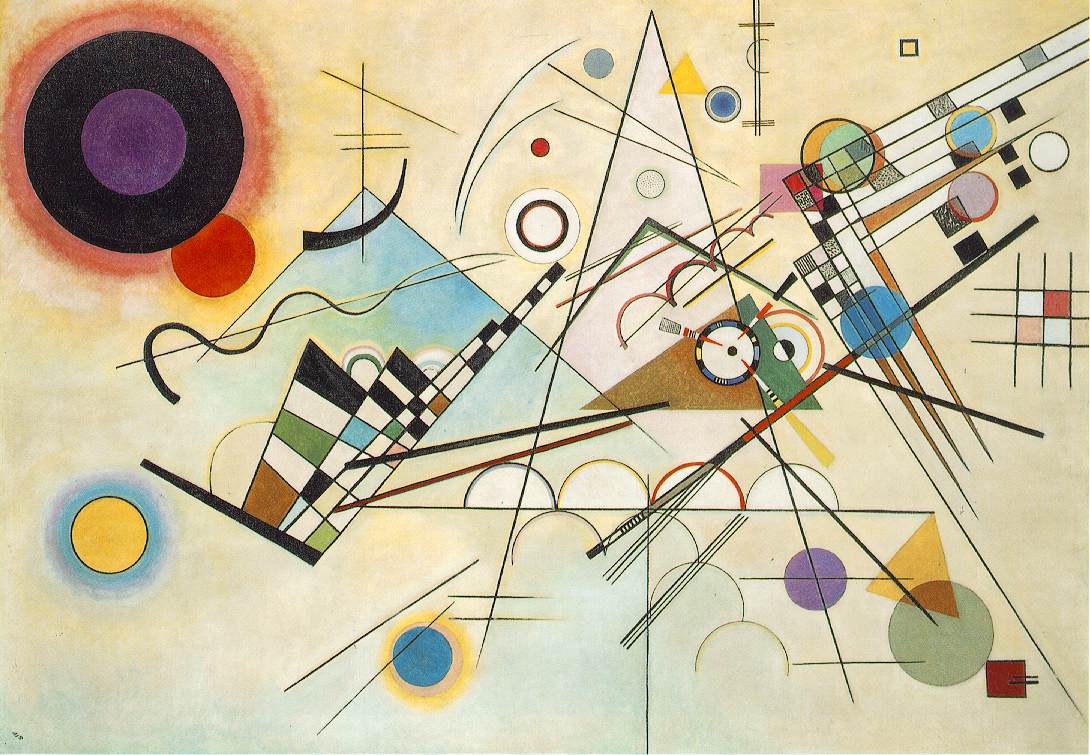 Vasily Kandisky | |
| date | 1913 |
|---|---|
Vasily Kandinsky was among the key pioneers of abstract art, along with the painters such as Piet Mondrian and Kazimir Malevich. He opened up an important new dimension of visual representation that explores another quality in pictures over and beyond portraying the directly apparent reality of the tangible word. [18]
The Intuition underlying Kandinsky's art has its origins in sources that rise far beyond all European Art Theory. His travels acquainted him with Modern Artists such as Seurat, van Gogh,
Cezanne, Matisse, and Picasso. Yet the works themselves are devoid of any evidence to suggest that his own painting was influenced by the traditional art of that time. [24]
Kandinsky found himself in a controversy to follow tradition and reality. The reality that impressionists like Monet included in their paintings. Kandinsky had new artistic objectives instead of "copying in paint". He sought to capture and represent in his painting a reality behind the visible world. The whole musicality of this paintings becomes evident in the use of the brush, the rhythm of the paint application, the intensity of the colors chosen, and the dimensions of the shapes and color fields were chosen. [18]
Cossacks
Wassily Kandinsky
Kandinsky believed that abstract paintings could convey spiritual and emotional values simply through the arrangement of colours and lines. Cossacks was made during a transitional period, when he retained some representational elements, such as the two Russian cavalrymen in tall orange hats in the foreground of the painting. Kandinsky considered these as points at which the images could be registered, rather than the true content of the painting. [25]
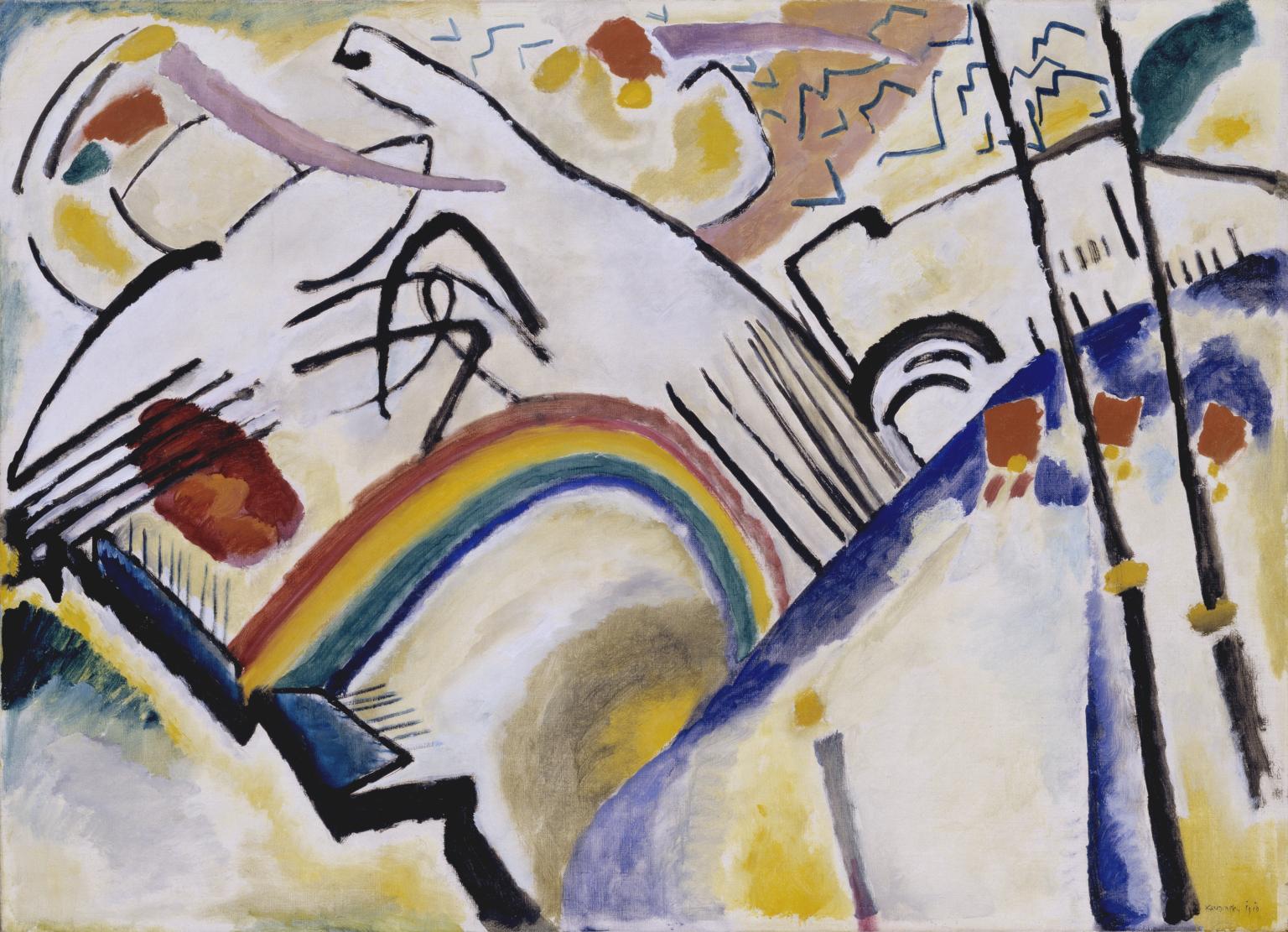 1910–1 | |
| Display Room | Level 2: Start Display |
|---|---|
A London Full of Colour
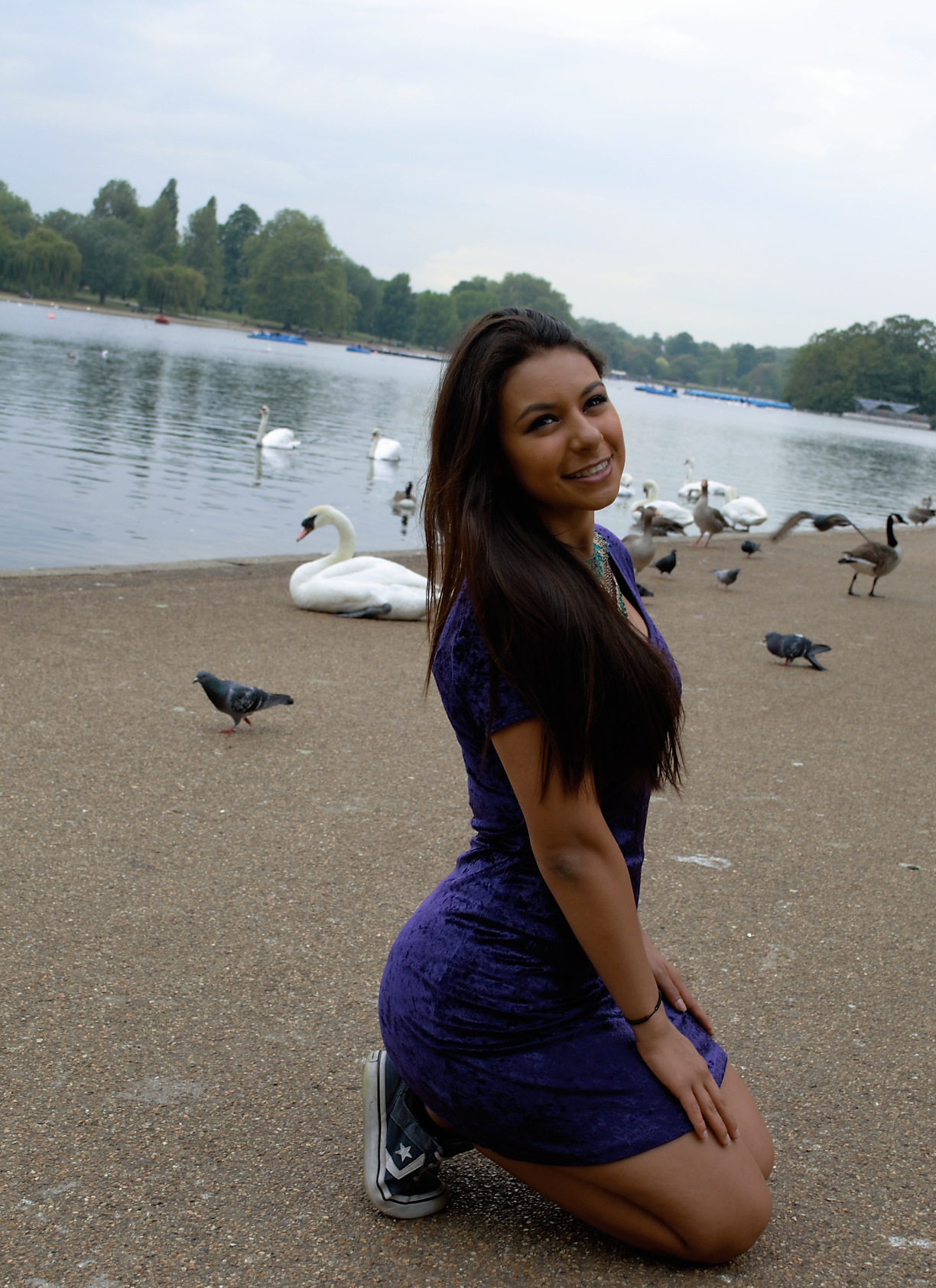 | |
| Location | Hyde Park |
|---|---|
Overview
"A London Full of Colour" is a project that aims to portray a different reality of the daily life of London citizens. By picturing different scenarios in their reality comparing them to the reality that I choose for each one of them, the audience is able to admire the beauty and uniqueness of the city from a different perspective. I have gone to international poetry competitions and taken painting and photography courses before arriving to college. This project combines my favorite forms of expression through art and hopefully brightens the days of the viewers. The main message I wished to convey is that every single one of us chooses the reality they want to live in, meaning that the same place could be seen as a prison for our souls or a wonderland for our imagination.
Milestone 1
Colourless London
Objective: The goal is to display London as it is and to capture through pictures emotions felt by the Londoners due to the weather. Pictures are taken from different perspectives and represent feelings of an average citizen.
In the course of two weeks, I researched the weather conditions in the United Kingdom, the origin of the deadly London fog and the relationship between people's emotions and weather conditions. This lead to the visual representation of my findings through a set of pictures taken on the city capturing the feelings talked about in the background. London looks like a majestic city and it's weather just adds to the mystery and enchantment of its beauty. However, people have had a different perspective than mine since centuries ago.
Read More
Milestone 2
Adding Pigment
Objective: The goal is to paint five acrylic surrealistic paintings of the most emblematic sites in London exaggerating the use of bright colors instead of the usual gray palette that is seen due to the weather.
The background exposes six different artists from three different fields; painting, literature, and architecture. From the magnificent paintings of Monet to the Breathtaking structures of Sir Christopher Wren and the stories of Charles Dickens together with Hockney's photographs, London is the birthplace of some of the most breathtaking artistic masterpieces. Unique, mesmerizing and complex, yet with a somehow volatile approach, artists throughout the history of this city have each shared their view through their work. Each one is analyzed in regard to the link between their style and perspective, and their setting and life circumstances. The artists are divided in "Artists from the past" and "Artists from the present" and while the first category shows monochromatic and deep emotions about the scenery in London, the second one proposes a new and brighter perspective to the same issue this city has dealt with for years.
Read More
Milestone 3
Colourful Reality
Objective: The goal is to connect the emotions displayed in the pictures and the colors of the paintings in a creative way empathizing with the people walking by the site as a daily routine. The paintings and pictures are accompanied by a poem.
Just as Mathew Arnold said; "Poetry is simply the most beautiful, impressive and widely effective mode of saying things". In this Milestone I explore the same reality from very different perspectives analyzing the lives of four of the most influential British Poets and one poem for each one of them. They all saw Britain grow and they grew with it as well, leaving a written proof of how each person is a master of their own destiny and how life is not about having, getting, and settling but about being, becoming and overcoming. These four authors that lived in very different times and lived in many places all through their lives show their personal view and chosen style through their work. We see through the writing of Mathew Arnold, Harry Baker, Richard Aldington and Don Patterson, different viewpoints about the weather and the sociopolitical situations that revolve around this the United Kingdom. What seems most interesting is the everlasting emotions displayed; everlasting in a way in which they are adopted again and again by newer generations as if the make choices and mistakes were made repeatedly throughout the ages. In this milestone it is possible to visualize the different perspectives of each author comparing them to each other and drawing your own conclusions.
Read More
- Jump up ↑ Schor, G. (2014). Woman: the feminist avant-garde of the 1970s: W orks from the Sammlung Verbund, Vienna. Brussels: Bozar Books.
- Jump up ↑ Bürger, P., & Shaw, M. (1984). Theory of the avant-garde. Minneapolis: University of Minnesota Press.
- Jump up ↑ Egbert, D. (1970). The Idea of avant-garde in Art and Politics. Leonardo, 3(1), 75-86. doi:10.2307/1572057
- Jump up ↑ Egbert, D. (1970). The Idea of avant-garde in Art and Politics. Leonardo, 3(1), 75-86. doi:10.2307/1572057
- Jump up ↑ T. (n.d.). Avant-garde – Art Term. Retrieved June 18, 2017, from http://www.tate.org.uk/art/art-terms/a/avant-garde
- Jump up ↑ Szabolcsi, M. (1971). Avant-Garde, Neo-Avant-Garde, Modernism: Questions and Suggestions. New Literary History, 3(1), 49-70. doi:10.2307/468380
- Jump up ↑ Neighborhood Guide to London. (2016, December 23). Retrieved June 17, 2017, from https://www.bohemiantrails.com/5-neighborhoods-of-london-avant-garde-traveler/
- Jump up ↑ About Us. (n.d.). Retrieved June 17, 2017, from http://theunitldn.com/about-us/
- Jump up ↑ About Us. (n.d.). Retrieved June 17, 2017, from http://theunitldn.com/about-us/
- Jump up ↑ About Us. (n.d.). Retrieved June 17, 2017, from http://theunitldn.com/about-us/
- Jump up ↑ T. (n.d.). Avant-garde – Art Term. Retrieved June 18, 2017, from http://www.tate.org.uk/art/art-terms/a/avant-garde
- Jump up ↑ Brettell, R. R. (2006). Modern art: 1851-1929: capitalism and representation. Oxford: Oxford University Press.
- Jump up ↑ Venturi, L. (1941). The Aesthetic Idea of Impressionism. The Journal of Aesthetics and Art Criticism, 1(1), 34-45. doi:10.2307/426742..
- Jump up ↑ Francis, H. (1960). Claude Monet Water Lilies. The Bulletin of the Cleveland Museum of Art, 47(8), 192-198.
- Jump up ↑ Stephens, Henry G. "Camille Pissarro, Impressionist." Brush and Pencil 13, no. 6 (1904): 411-35. doi:10.2307/25503707.
- Jump up ↑ Venturi, Lionello. "The Aesthetic Idea of Impressionism." The Journal of Aesthetics and Art Criticism 1, no. 1 (1941): 34-45. doi:10.2307/426742.
- Jump up ↑ Nochlin, Linda, ed. Impressionism and Post-Impressionism, 1874–1904: Sources and Documents. Englewood Cliffs, N.J.: Prentice-Hall, 1966.
- ↑ Jump up to: 18.0 18.1 18.2 18.3 18.4 Kandinsky, W., Friedel, H., Hoberg, A., & Benesch, E. (2016). Vasily Kandinsky. Munich: Prestel Verlag..
- Jump up ↑ Holzwarth, H. W., Taschen, L., & Elger, D. (2011). Modern art. Köln: Taschen.
- Jump up ↑ T. (n.d.). Cubism – Art Term. Retrieved May 16, 2017, from http://www.tate.org.uk/art/art-terms/c/cubism
- Jump up ↑ T. (n.d.). Picasso. Retrieved May 18, 2017, fromhttps://www.google.com/culturalinstitute/beta/search?q=Picasso
- Jump up ↑ Ian Chilvers & John Glaves-Smith, A Dictionary of Modern and Contemporary Art. Oxford University Press, p. 203
- Jump up ↑ Audio Arts: Volume 2 No 4. (n.d.). Retrieved June 17, 2017, from http://www.tate.org.uk/audio-arts/volume-2/number-4
- Jump up ↑ Grohmann, W., & Briod, B. (1930). Vassily Kandinsky: sa vie, son oeuvre. Paris: Flammarion.
- Jump up ↑ Tate. "'Cossacks', Wassily Kandinsky, 1910-1." Tate. N.p., n.d. Web. 21 June 2017. <http://www.tate.org.uk/art/artworks/kandinsky-cossacks-n04948>.
